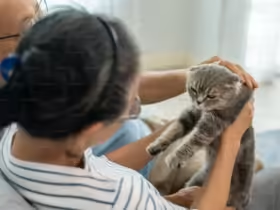Cat lice may not be the most talked-about parasite, but they can affect our feline friends and cause discomfort. Understanding whether cat lice are common, recognizing the symptoms of an infestation, and knowing how to treat and prevent lice are essential for keeping your cat healthy and comfortable. This comprehensive guide will provide you with all the information you need about cat lice.
Understanding Cat Lice
What Are Cat Lice?
Cat lice are small, wingless parasites that live on the skin and fur of cats. Unlike fleas or ticks, lice are host-specific, meaning they only infest cats and cannot transfer to humans or other animals. There are two main types of lice that affect cats:
- Chewing Lice (Mallophaga): These lice feed on skin flakes, debris, and sometimes blood.
- Sucking Lice (Anoplura): These lice feed directly on the blood of their host.
Are Cat Lice Common?
Lice infestations in cats are relatively rare compared to fleas and ticks. However, they can occur, particularly in situations where cats have poor hygiene, are overcrowded, or have compromised immune systems. Lice infestations are more common in:
- Stray or Feral Cats: These cats are more likely to be exposed to lice due to their environment and lack of regular grooming.
- Cats in Poor Health: Cats with weakened immune systems or underlying health issues are more susceptible to lice infestations.
- Shelters and Catteries: Overcrowded conditions and close contact with other cats can increase the risk of lice spreading.
Recognizing Symptoms of Lice Infestation
Common Symptoms
Identifying lice infestations early can help prevent further issues. Look out for the following signs:
- Itching and Scratching: Lice can cause significant itching, leading your cat to scratch or groom excessively.
- Hair Loss: Frequent scratching and biting can result in patches of hair loss.
- Red or Inflamed Skin: The affected areas may become red, inflamed, or irritated.
- Visible Lice: You may see lice or their eggs (nits) in your cat’s fur. Lice are tiny, ranging from 1 to 2 mm in length, and are often found close to the skin.
Behavioral Changes
In addition to physical symptoms, lice can cause behavioral changes:
- Restlessness: Your cat may appear restless or uncomfortable due to itching.
- Reduced Activity: The discomfort may lead to decreased playfulness or activity.
Diagnosing Lice Infestation
Veterinary Examination
If you suspect your cat has lice, a visit to the veterinarian is essential for an accurate diagnosis and appropriate treatment. The vet will:
- Perform a Physical Exam: To check for signs of lice, such as itching, hair loss, and skin inflammation.
- Examine Fur and Skin: Using a fine-toothed comb to check for lice and nits.
- Conduct Diagnostic Tests: If necessary, to rule out other conditions with similar symptoms, such as mites or fungal infections.
Treating Cat Lice
Topical Treatments
Treatment for lice typically involves topical products designed to kill lice and their eggs:
- Lice Shampoo: Specially formulated shampoos can help eliminate lice and nits. Follow the instructions carefully and use the product as directed.
- Topical Treatments: Spot-on treatments containing insecticides or antiparasitics are effective in killing lice. Apply these treatments according to your vet’s recommendations.
Oral Medications
In some cases, oral medications may be prescribed to treat lice infestations. These medications work by killing lice from within and are often used in combination with topical treatments.
Environmental Control
Preventing reinfestation involves addressing the environment:
- Clean Bedding and Living Areas: Wash your cat’s bedding, toys, and any other items they come into contact with in hot water to kill any lice or eggs.
- Vacuum Thoroughly: Vacuum carpets, furniture, and other areas where your cat spends time to remove lice and eggs.
- Disinfect: Use pet-safe disinfectants to clean surfaces and prevent lice from spreading.
Preventing Lice Infestations
Regular Grooming
Regular grooming can help prevent lice infestations:
- Brush Your Cat: Regularly brushing your cat helps remove debris and can help you spot any lice or nits early.
- Check for Parasites: During grooming, check for signs of lice or other parasites and consult your vet if you find anything suspicious.
Maintain a Clean Environment
Keeping your cat’s living environment clean can reduce the risk of lice:
- Keep Bedding Clean: Wash your cat’s bedding and any fabric items they come into contact with regularly.
- Maintain Good Hygiene: Ensure that your cat is housed in a clean, hygienic environment to minimize the risk of lice and other parasites.
Avoid Contact with Infected Cats
Preventing lice infestations involves limiting exposure to infected animals:
- Isolate New Cats: Quarantine new or unknown cats before introducing them to your household to prevent potential lice transmission.
- Monitor Social Interactions: If your cat interacts with other animals, be vigilant for signs of lice and address any issues promptly.
When to See a Veterinarian
Seek veterinary attention if:
- Symptoms Persist: If your cat continues to exhibit signs of lice despite treatment.
- Severe Infestation: If your cat shows severe symptoms, such as significant hair loss or skin infections.
- Underlying Health Issues: If you suspect that lice may be related to underlying health problems or a compromised immune system.











Leave a Reply